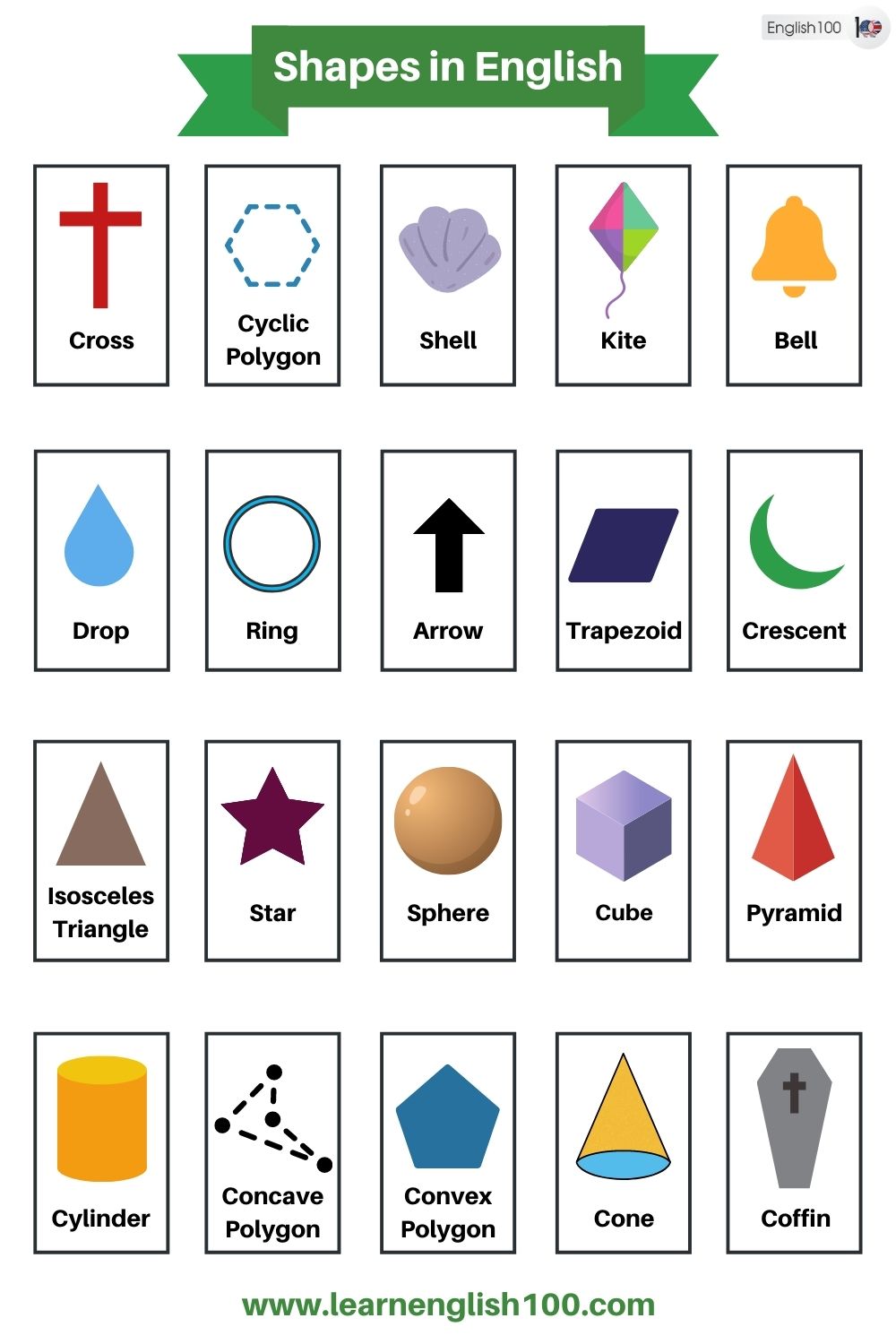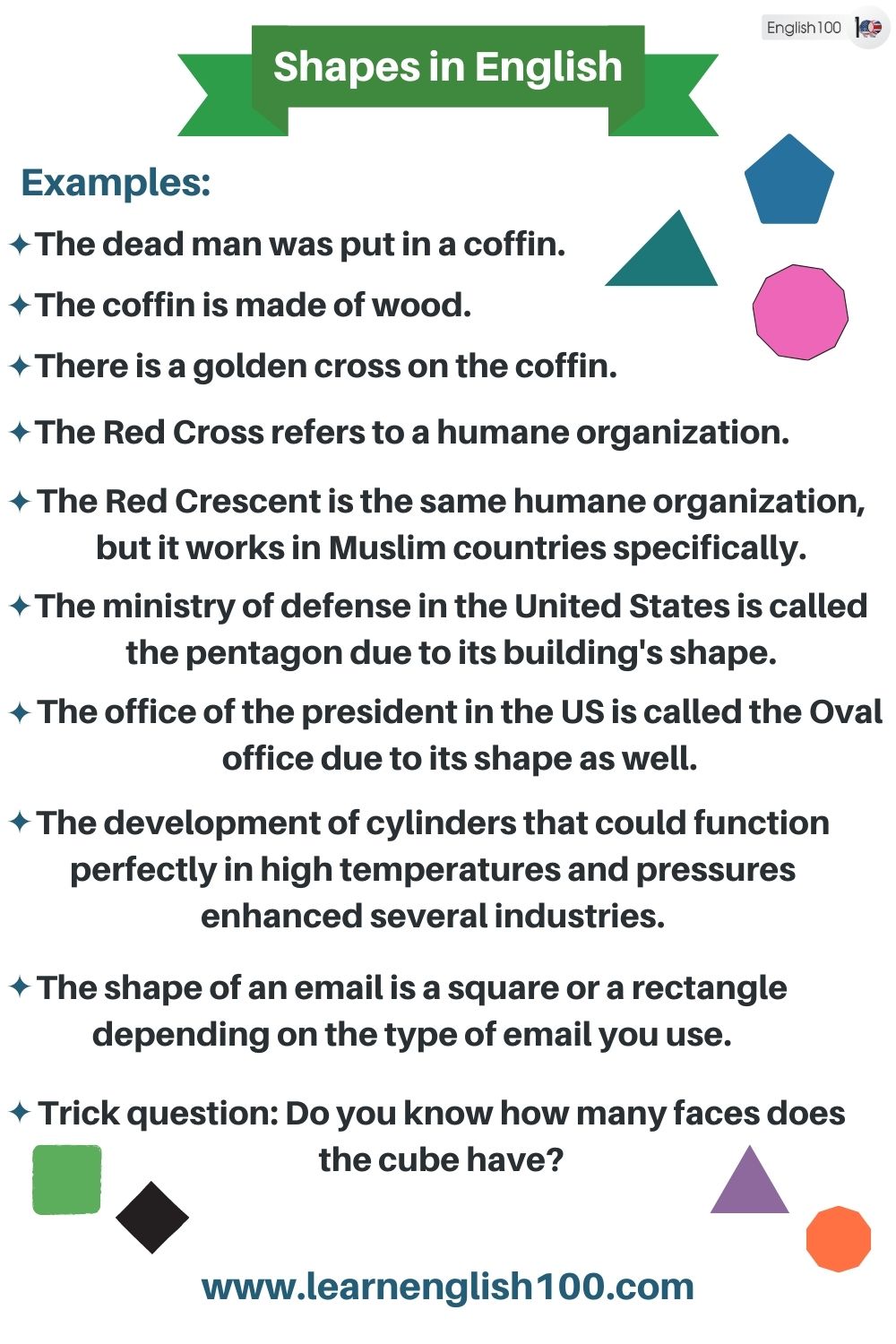Exploring the 100 shapes name offers a fascinating dive into geometry, uncovering both familiar and complex forms. Understanding the types of shapes and their names like hexagons, trapezoids, and ellipses expands your visual vocabulary. Each shape holds unique properties, contributing to design, architecture, and even nature’s patterns.




Shapes are all around us, whether we realize it or not. From the moment we are born, we encounter an array of shapes in our daily lives. These geometric forms play a crucial role in both mathematics and art, serving as the building blocks for understanding the world around us.
In this article, we will delve into the fascinating realm of shapes, exploring their different types and all shapes names. There are many shapes in the world – Let’s get to know their names in English and their different characteristics.
The Basics of Shapes
Shapes are defined as two-dimensional, flat, enclosed areas with specific boundaries. They can be categorized into two primary groups: geometric and organic shapes. Geometric shapes are precise and well-defined, while organic shapes are more irregular and freeform, often resembling objects found in nature.
Shapes List – shapes name
- Circle
- Oval
- Rectangle
- Square
- Triangle
- Pentagon
- Heptagon
- Octagon
- Nonagon
- Hexagon
- Decagon
- Leaf
- Semi-Circle
- Scalene Triangle
- Right Triangle
- Parallelogram
- Rhombus
- Trefoil
- Heart
- Abstract
- Ellipse
- Cross
- Cyclic Polygon
- Balbis
- Club
- Bell
- Drop
- Apeirogon
- Arrow
- Trapezoid
- Crescent
- Isosceles Triangle
- Star
Some definitions of basic shapes
Common Geometric Shapes and Their Names – 10 shapes name
- Circle :The circle is a perfectly round shape with all points equidistant from its center. It has no corners or angles. Examples of circles include the sun, the moon, and a pizza.
- Square: A square has four equal sides and four right angles. It is characterized by its straight edges and sharp corners. Common objects in the shape of a square include books and picture frames.
- Triangle: A triangle has three sides and three angles. The most basic type of triangle is the equilateral triangle, where all sides and angles are equal. Other types include isosceles and scalene triangles.
- Rectangle: A rectangle has two pairs of equal-length sides and four right angles. Common items with a rectangular shape include doors, windows, and computer screens.
- Pentagon: A pentagon has five sides and five angles. The most famous example of a pentagon is the Pentagon building in Washington, D.C.
- Hexagon: A hexagon has six sides and six angles. Honeycomb cells in beehives are often hexagonal in shape.
- Octagon: An octagon has eight sides and eight angles. Stop signs are a classic example of octagonal shapes.
- Oval: An oval is similar to a circle but stretched in one direction. It has no right angles or equal sides. Many sports fields, such as those for track and field events, are oval in shape.
- Rhombus: A rhombus has four equal sides but does not necessarily have right angles. Diamonds are typically cut into a rhombus shape.
- Trapezoid: A trapezoid has four sides with one pair of parallel sides. It may have right angles or be slanted.
Three-Dimensional Shapes
- Sphere
- Cube
- Pyramid
- Cylinder
- Concave Polygon
- Convex Polygon
- Equiangular Polygon
- Cone
- Rectangular Prism
- Ring = Annulus
- Kite
- Shell
Note that some three-dimensional shapes could occur in two-dimensional forms. Abstract shapes are those that do not conform to regular geometric rules, meaning they cannot be easily described by counting angles and sides. Additionally, some two-dimensional shapes, like a star, can also be represented in three-dimensional forms.
Examples:
- The Red Cross refers to a humane organization.
- The Red Crescent is the same humane organization, but it works in Muslim countries specifically.
- The ministry of defense in the United States is called the pentagon due to its building’s shape.
- The office of the president in the US is called the Oval office due to its shape as well.
- The development of cylinders that could function perfectly in high temperatures and pressures enhanced several industries.
- The shape of an email is a square or a rectangle depending on the type of email you use.
Trick question: Do you know how many faces does the cube have?
The choices:
4 – 6 – 8 – 10 – 12 faces!
- When there is an accident, the police put up cones to redirect traffic to smoother and more open roads.
- The Earth is round and not circular since it is a three-dimensional shape while a circle is only a two-dimensional shape.
- The movement of the Earth is circular, but its shape is round.
- Just like a ball, all planets are round not circular.
- Stars look like the common shape of a star, but they are either round or abstract entities.
- A sphere is just like a rounded ball, and it usually encircles another entity inside it.
- We hope that you enjoyed the article and learned the names and the shapes in English easily!
FAQ
What are some shapes in English?
In English, there are many shapes, and they can be broadly categorized into two main groups: geometric shapes and organic shapes.
Geometric Shapes:
Circle: A perfectly round shape with no corners or angles.
Square: A shape with four equal sides and four right angles.
Triangle: A shape with three sides and three angles.
Rectangle: A shape with two pairs of equal-length sides and four right angles.
Pentagon: A shape with five sides and five angles.
Hexagon: A shape with six sides and six angles.
Octagon: A shape with eight sides and eight angles.
Oval: A shape similar to a circle but stretched in one direction.
Rhombus: A shape with four equal sides but not necessarily right angles.
Trapezoid: A shape with four sides and at least one pair of parallel sides.
Organic Shapes:
Organic shapes are irregular and freeform, often resembling objects found in nature. They don’t have the precise, defined characteristics of geometric shapes and can vary widely in appearance. Examples of organic shapes include clouds, leaves, rocks, and the outlines of various animals and plants.
These are just a few examples of shapes in English, and there are many more shapes and variations to explore within each category. Shapes are an essential part of our everyday lives, and understanding their names and properties can be useful in various contexts, from art and design to mathematics and everyday communication.
What is basic shapes?
Basic shapes are fundamental geometric forms that serve as building blocks for more complex shapes and structures. These shapes are typically simple and easily recognizable, and they include:
Circle: A perfectly round shape with all points equidistant from its center.
Square: A shape with four equal sides and four right angles.
Triangle: A shape with three sides and three angles.
Rectangle: A shape with two pairs of equal-length sides and four right angles.
Pentagon: A shape with five sides and five angles.
Hexagon: A shape with six sides and six angles.
These basic shapes provide a foundation for understanding and working with more complex shapes in mathematics, art, and various fields of study. They are essential for teaching geometry and are commonly encountered in everyday objects and designs.
What are 12 shapes?
Here are 12 shapes:
Circle
Square
Triangle
Rectangle
Pentagon
Hexagon
Octagon
Oval
Rhombus
Trapezoid
Parallelogram
Star
These are a dozen common geometric shapes, each with its own unique characteristics and properties.
To conclude, shapes are more than just mathematical concepts; they are fundamental elements that surround us every day. Understanding the different types of shapes and their names not only enriches our knowledge but also enhances our ability to appreciate the beauty and symmetry in the world. Whether you’re solving math problems, creating art, or simply admiring the world around you, shapes are an integral part of the visual language we use to describe our environment. So, the next time you encounter a shape, take a moment to appreciate its unique qualities and the role it plays in our world. What is your favourite shape name?
